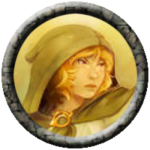...and your point is?

The images have a certain JonBenet Ramsey quality to them. Kinda squicky.
I'd try to draw one if I knew what a typical PC token looked like.
This is what I ended up with. The artist intended it to be a halfling, although it doesn't exactly scream "halfling" to me. But at least it isn't creepy.
Once I select an image, I drop it into a program that can make various borders. I pilfer the web for these things, since they are for my home game. I would link the artist, but I'm having trouble finding the image again (EDIT, I found the artist,
here is the link).

Above is a token for a nameless NPC. If they get elevated to named/recurring NPC, they get a headshot instead:

I can use these tokens in the virtual tabletop I use (MapTools). I can then assign properties and macros to the token. So if the NPC is going to make an attack, I click an attack button that is attached to a macro. It then asks who I am attacking, and I click on the victim's token. It rolls the dice, adds appropriate modifiers, and compares to the victim's defences to see if I hit; then it calculates damage, and assigns any conditions to the victim's token.
I haven't run any other VTT, so I don't know how they compare. I do know you can do a lot with MapTools if you are good at coding. I'm not good at coding, but other users share their macros, and I know just enough that I can usually integrate them into the framework I'm using.
This may be old hat to some of the people here, but I'm assuing you (
@squeen) don't use a VTT.













